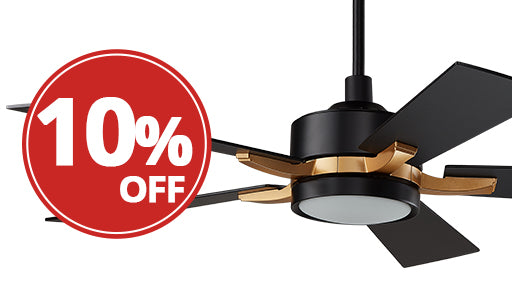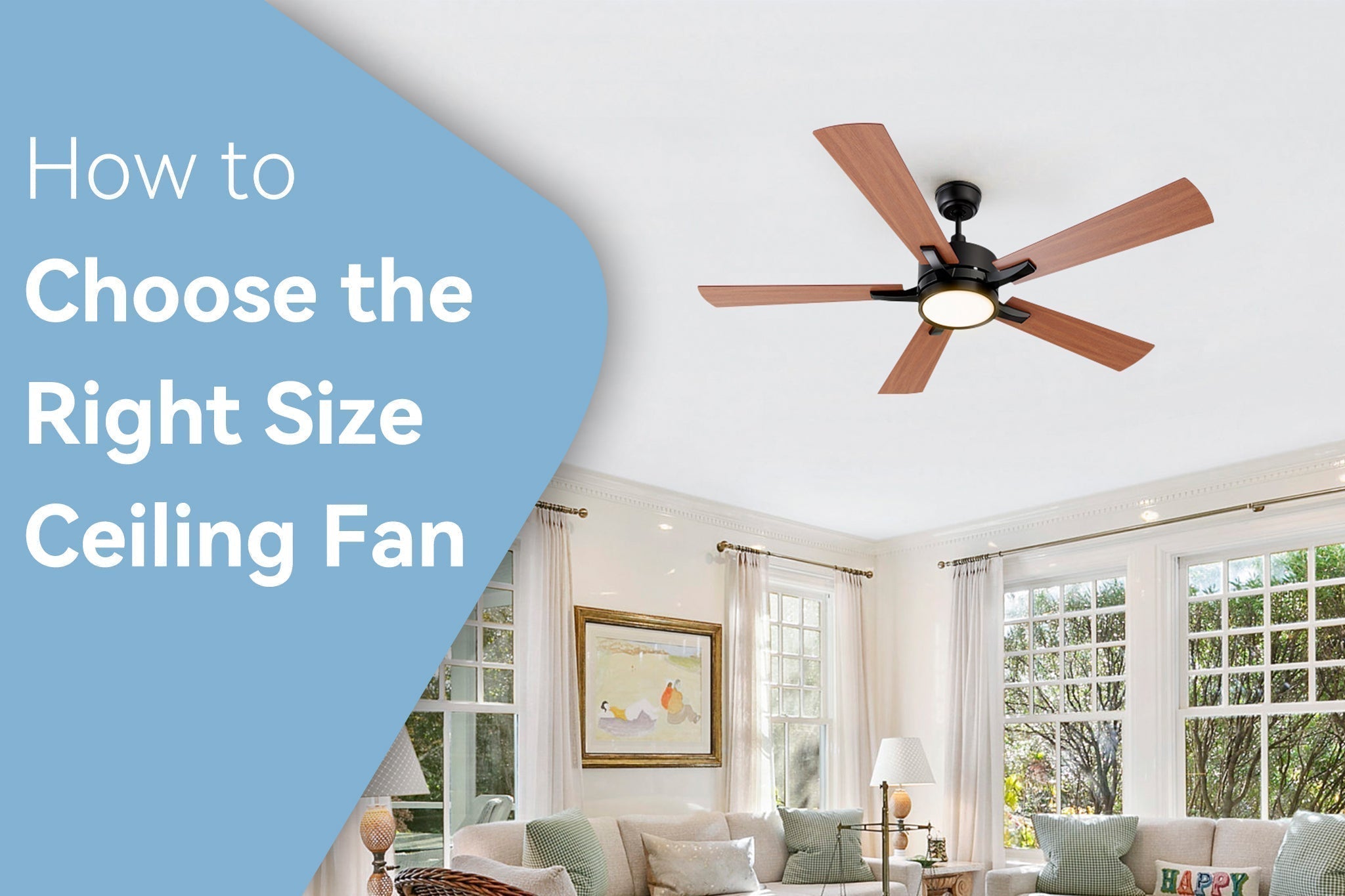Choosing the right size ceiling fan is like finding the perfect shoe size. You're looking for optimal comfort without compromising style or breaking the bank. Unfortunately, it's impossible to go around trying on ceiling fans until you find the perfect fit. That's why we've created this handy size guide to help you select the ideal ceiling fan size.
1. Measuring the Room Square Footage

Even the most powerful fan will have trouble cooling a room that is too big for its size. So, it's important that you know how to measure your room size to select the proper ceiling fan. Measuring the square footage of your room is simple! All you'll need is a tape measure and something to take notes with.
Step 1: Remove anything that will interfere with your measurements, such as furniture or décor.
Step 2: Take the end of your tape measure and place it against the wall. Make sure it doesn't move away from the wall.
Step 3: Walk the tape measure to the other end of the wall.
Step 4: Record the foot measurement.
Step 5: Repeat this process to find the measurement of the opposing walls.
Step 6: Multiply the two measurements (Length x Width) to calculate the square footage.
Pro-Tip: For an irregular-shaped room, you want to section it out into two regular shapes. For example, an L-shaped room would be divided into a square and a rectangle. Following the steps above, calculate the square footage of each independently, and then add the two square footage measurements to calculate the square footage of the entire room.
2. Measuring the Ceiling Fan Diameter

Now that you've calculated your square footage, it's time to move on to the measure fan size. While shopping for fans, you'll notice the measurement, in inches, on the box or label. This measurement describes the diameter or the distance from the end of a blade to the end of an opposite blade. Knowing how to measure your ceiling fan blade span is important because it can help you decide where to place your fan to avoid blade collisions and the right air distribution.
Measuring this on your own is easy:
Odd Blades - If you have a fan with an odd number of blades, calculating the blade sweep is a little different. You'll start by measuring the distance from the tip of a blade to the middle of the ceiling fan's motor hub, also known as the radius. Next, you'll multiply this by 2 to calculate the diameter.
Even Blades - If you have a ceiling fan with an even number of blades, just measure from the end of a blade to the end of an opposite blade to calculate the blade sweep.
3. Measuring the Ceiling Height

Knowing the height of your ceiling can help you decide the type of mounting you'll need. For higher, slightly sloped surfaces, we recommend a ceiling fan with a downrod mount. For low ceilings, Smafan has a broad selection of low-profile ceiling fans that feature a sleek and direct flush mount.
Measuring your ceiling height is simple, just use a ladder and a tape measure to determine the distance between the ceiling and the floor.
Suggested Downrod Length

To figure out the suggested downrod length, you'll need to take your ceiling height and subtract the height of the fan along with the height you'd like your ceiling fan to hang:
(Ceiling Height – Ceiling Fan Height) – Hanging Length Desired = Suggested Downrod Length
4. Selecting a Fan

Now that you have the room size, the ceiling fan size, and the ceiling height, you're ready to choose a ceiling fan!
· Small: For rooms between 75 – 144 ft², we recommend ceiling fan sizes 36” – 48”
· Large: For rooms between 145 – 300 ft², we recommend ceiling fan sizes 50” – 52”
· Great Size: for rooms 300 ft² and up, we recommend ceiling fan sizes 56” – 60”
Remember to select the mounting option or downrod length appropriate for your ceiling. For more tips on selecting the proper ceiling fan for varying room sizes, please refer to our blog: Ceiling Fan Size and Installation Tips!
5. You Also Want to Consider...

- Consider the noise level: Look for ceiling fans with quiet motors, especially DC motors, to ensure a peaceful environment in your room.
- Opt for energy-efficient models: Choose ceiling fans that are ENERGY STAR certified to save on electricity bills and reduce your carbon footprint.
- Select the right controls: Decide whether you prefer a fan with a wall switch, pull chains, or a remote control or voice command app control for easy operation.
- Pay attention to the lighting: Some ceiling fans come with built-in light fixtures, which can be a convenient option if you need both lighting and air circulation in your room.
- Don't forget about the warranty: Look for ceiling fans that come with a reliable warranty to protect your investment.
Now that you've got the basics of ceiling fan size down, here are some additional things to keep in mind:
Light Kit Size - Lightbulbs are a thing of the past! Most modern ceiling fans are equipped with LED light kits that deliver long-lasting and versatile lighting options. They are attached to the fan's motor hub and are covered by a protective lampshade. Make sure to take into consideration the height of the light kit when selecting the downrod and placement for your ceiling fan!
Ceiling Slope - Before you purchase a ceiling fan, make sure it's compatible with the slope of your ceiling! Many models, especially flush-mount ceiling fans, are only compatible with even ceiling surfaces. Even downrod-mounted ceiling fans require an angled mounting kit after a certain slope degree. Smafan's downrod-mounted fans are compatible with sloped ceiling surfaces of up to 27 degrees. To ensure a safe installation and secure use, double-check the fan product specs and compare them to the angle of your ceiling.
Ceiling Obstructions - Look out for the obstructions! Before installing your ceiling fan, you'll want to remove any obstructions that may impede your ceiling fan blades from spinning, including any light fixtures, décor, or existing structures. If supportive structures are in the way of your fan blades, you'll need to adjust the length of the downrod for proper positioning.
Proper Weight Support - Verify that your ceiling and fan brace are designed to support the weight of your ceiling fan. Most ceiling fan braces have a weight limit printed on the packaging or on the side of the brace itself. If you're unsure, it's best to go out and buy a ceiling brace with the proper capacity and junction box for ceiling fans.
Ready to shop like a pro? Head over to Smafan's Smart Ceiling Fans page to explore our modern cooling options. From our 36-inch compact and commanding units to our 60-inch large and in-charge models, Smafan has a variety of fan sizes to fit perfectly in any space. All our fans are designed with advanced technology and premium materials so you can bring reliable and stylish cooling to your home!

























